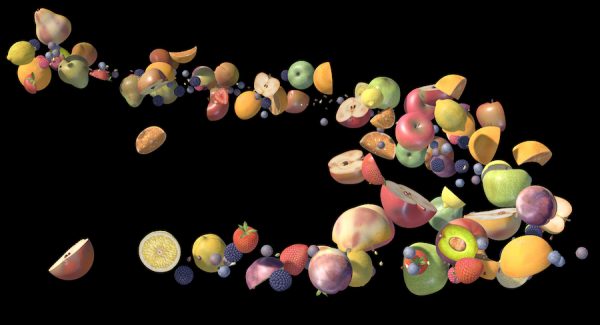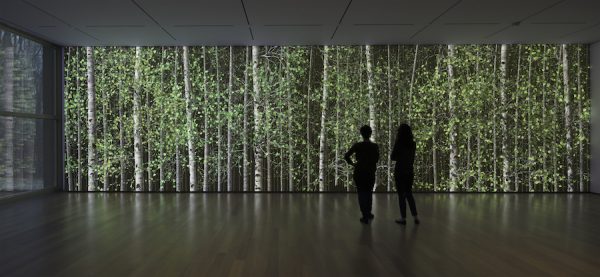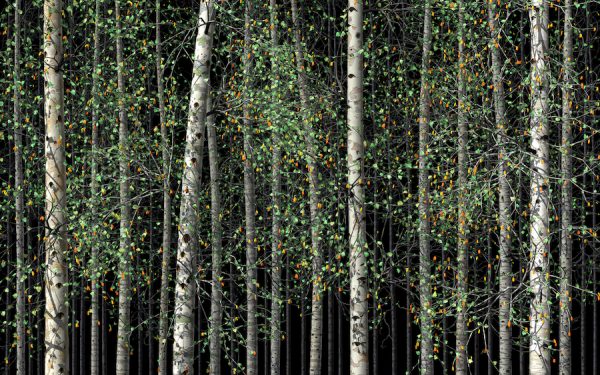
Jennifer Steinkamp, Womb, 2019. Virtual reality interactive animation with sound. Artistic programming and sound by Alex Rickett. Dimensions variable.
In the year 2000, in response to a question posed to Los Angeles-based artist Jennifer Steinkamp about the future of art in the 21st century, Steinkamp predicted that the art would become more genetic or biological, and that her work would be “out of the loop.” She couldn’t have been more wrong.
Steinkamp is recognized as a pioneer in 3-D animation and new media. For more than 30 years, her large-scale digital installations have been exhibited extensively around the world in museums, galleries and public spaces. Although her work has been shown in Houston (Rice Gallery in 2001; MFAH 2012, 2014, ) and San Antonio (The McNay, 2016), Steinkamp’s show at Talley Dunn Gallery in Dallas, opening this weekend, marks her first exhibit in Dallas since a Victory Park showing in 2007.
When reading about Steinkamp’s work, I noticed that most articles emphasized her use of technology and formal elements of space, perception and motion. While the works are awe-inspiring, technologically, I was more interested in decoding some of the ideas embedded in the work.
At a time when many big-name artists employ a studio full of assistants, Steinkamp (who is also a professor of art at UCLA), chooses to work alone.
Colette Copeland: I remember my first encounter with your work in 2007 at the Locks Gallery in Philadelphia. I was mesmerized by the immersive experience; there was something very tactile and welcoming about the work, whereas a lot of media-based art maintains a distance between the viewer and work. How do you navigate within the technology to create that experience for the viewer? As technology and software has advanced, how has your process changed in terms of creating the installations and viewing environment?
Jennifer Steinkamp: It is funny; twelve years does not seem like a long time ago, but so much can change in that short period. For example, we were not using smart phones with internet access very much; the iPhone just came out.
Rapunzel was the name of the piece you saw. The work is a self-portrait, starting off as a playful way to think about hair simulations and diving deep into the fairy tale titled Rapunzel — the story about the young woman locked in a tower with really long hair. In the beginning of the story, the darker part that people tend to forget is the idea of giving up your child to an addiction. Rapunzel’s parents do this when they give their child over to their neighbor in exchange for the flower called rampion. Similarly, my parents gave up my brothers, sisters and me for their addictions to alcohol and gambling. I believe creating a self-portrait can give the viewer a chance to know the artist and perhaps connect a little deeper to the artistic intensions.
I recently worked on a Merce Cunningham dance performance. I had some time to meet the dancers and get to know them. This completely changed my experience of watching their performances; I was more engaged. As with dance, movement in animation is another way to connect with the viewer; your corporeal body and mind feel it.
As technology changes and disappears, I have more tools, more speed, more polygons and more resolution, but over the years I have had to give up some of my old tools. Apple and Adobe are shameless about taking away this legacy. (I have added this problem to my billionaire bucket list.)
CC: A lot has been written about your work in relationship to the formal elements of space, perspective, perception and the use of beauty to create a simulated natural environment. However, I sense a strong underlying conceptual current relating the works to socio-political issues.
JS: For me, beauty has the potential to give you a strong existential feeling that makes you wonder what it can mean to be alive and conscious.

Jennifer Steinkamp, Womb, 2019. Virtual reality interactive animation with sound. Artistic programming and sound by Alex Rickett. Dimensions variable.
CC: Your work Womb [upcoming at Talley Dunn] depicts a pattern of moving fruit “ovaries” that features sound from The Wizard of Oz. The work made me think about threats to overturn Roe vs Wade and the eight states that have passed abortion bans this year. The Wizard of Oz references the opiate-induced stupor of complacency, like the one that plagues the U.S. as women lose control over their bodies.
JS: I think about how female ovaries are overlooked in the most basic aspects of our culture. Your interpretation makes sense, too. I do wish people would understand anti-abortion policies are all about controlling women. For example, people who are opposed to abortion should be even more opposed to in vitro fertilization; more fetal cells are utilized and tossed during IVF procedures. (I am not opposed to either choice.) Most importantly, people need to consider how and why they are controlling women. Everyone needs access to better birth control. And men need to stop raping women and children.
CC: Your work Blind Eye makes me think about climate change and the eradication of the environment. There’s a quote by Tim Flannery in the book The Hidden Life of Trees: What They Feel, How They Communicate—Discoveries from a Secret World that states: “A tree’s most important means of staying connected to other trees is a ‘wood wide web’ of soil fungi that connects vegetation in an intimate network that allows the sharing of an enormous amount of information and goods.” The Blind Eye works present a future where all of nature is simulated and the virtual trees are tightly networked and sentient.
JS: I am fascinated by the recent discoveries that trees communicate through an underground chemical exchange; the Radiolab episode where they discussed this was amazing. You can certainly sense the incorporeal in nature. If anything, this is a consistent current in my work. There is so much we can just barely sense and feel; yes, I believe we are surrounded by sentience. I use the tangible invisible forces in air to communicate this — for example, the tornado wind sound from The Wizard of Oz.
CC: The titles in particular give me a sense that the socio-political ideas are presented in a subversive manner, shrouded in a veil of beauty.
JS: The title Blind Eye is a play on words: it refers to a tree blind; it also conveys the singular eye scars left on birch trees after they lose their branches; it is seeing with one eye, or monocular vision; there are so many things we turn a blind eye to these days — Trump pulling out of the Paris Agreement is among the most hideous. We are dumping carbon and methane gases into the atmosphere, changing the climate at exceeding rates.
CC: As an internationally recognized, prolific artist, I was surprised that you maintain a teaching position at UCLA in Design Media Arts. The Judy Crook works honor teachers with tree dedications, which is a lovely way to recognize mentors and unseen heroes who shape our lives. As an educator, I find that work to be especially poignant and moving. Why do you teach? How does teaching inform your practice? What have been some of the most important things you learned from your teachers?
JS: Teaching is an awesome challenge for me. I would like to help people find what they are interested in, and why they are attracted to their interests; so many mentors from my past helped me in this way.
I learned a lot from my teacher Judy Crook. She always spoke a little above us; you really had to think about what she said. She made me love color theory. She was an incredible role model.
CC: You spend a lot of time on the computer. What do you do during all that rendering time? What do you like to do when you are not in front of a computer?
JS: I love my friends, I enjoy long walks, and I enjoy reading and research as inspiration. I get pleasure from science fiction and new technologies; I like to imagine how simple daily routines will be changed by science art and culture. What would our lives be like if we delay aging and live 20 years longer? How does this affect the number of careers we would decide to pursue?
CC: What are you interested in right now?
JS: Lately, I am thinking about why all these women choose to vote against their own interests. Why would a woman decide to put a republican, or worse, a fake republican in office? My mind keeps blaming the church; the false morality of religion has the largest control over women. I like to play this futurist mind game with myself: what would a religion not based on white male supremacy look like? Then perhaps religion could realize true spiritual enlightenment.
This interview has been lightly edited for length and clarity.
‘Jennifer Steinkamp: Womb’ will be on view at Talley Dunn Gallery, Dallas, August 24-October 12, 2019. Opening reception for the artist: Saturday, August 24, from 6–8 pm. Artist remarks begin at 6:30 pm.







2 comments
Thanks for the great interview! — Steinkamp’s work is in season two of The OA (marvelous show), you helped connect those dots.
Thank you for reading John! I didn’t know her work was in The OA. I will have to check out the show.